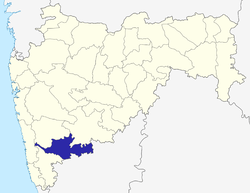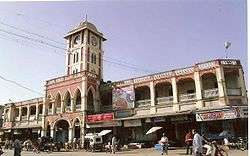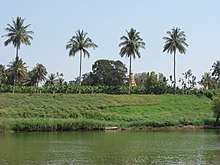Sangli district
Sangli District is a district of Maharashtra State in west-central India. Sangli City is the district headquarters. The district is 25.11% urban. Sangli and Miraj are the largest cities. The industrial town of Kirloskarwadi is also located in the Sangli District. Industrialist Laxmanrao Kirloskar started his first factory here. It is known as the sugar bowl of India due to its high sugarcane productivity. Sangli District is one of the most fertile and highly developed districts in Maharashtra. The District is very popular as a political power house in the state. It has provided many politicians and bureaucrats and is often referred to as the Heaven of Farmers.
Sangli district | |
|---|---|
District of Maharashtra | |
 Location of Sangli district in Maharashtra | |
| Country | India |
| State | Maharashtra |
| Division | Pune Division |
| Headquarters | Sangli |
| Tehsils | |
| Government | |
| • Lok Sabha constituencies |
|
| Area | |
| • Total | 8,572 km2 (3,310 sq mi) |
| Population (2011) | |
| • Total | 2,822,143 |
| • Density | 330/km2 (850/sq mi) |
| • Urban | 25.11% |
| Demographics | |
| • Literacy | 82.41% |
| Time zone | UTC+05:30 (IST) |
| Major highways | NH-4, NH-204 |
| Average annual precipitation | 400–450 mm |
| Website | http://sangli.gov.in/ |
History
The district of sangli is a recent creation, being made as late as in 1949. It was then known as South Satara and it has been renamed as Sangli since 1961. It is partly made up of a few talukas which once formed part of the old Satara District and partly of the States and jahagirs belonging to Patvardhans, and Dafles which came to be merged during the post-independence period. Kundal, the region around Sangli, was the capital of the Chalukyas. Kundal was an ancient village, around 1,600 years old. Kaundanyapur (its old name) was a part of Karnataka.[2]
Geography
Sangli District is located in the western part of Maharashtra. It is bounded by Satara and Solapur districts to the north, Bijapur District (Karnataka) to the east, Kolhapur and Belgaum (Karnataka) districts to the south, and Ratnagiri District to the west.
Sangli District is situated in the river basins of the Warna and Krishna rivers. Other small rivers, such as the Warana and the Panchganga, flow into the River Krishna. Land in the region is suitable for agriculture.
Sangli district has distinct kind of environment. Eastern talukas of Shirala, Walwa, Palus are famous for high rainfall and floods. 2005 floods submerged many villages like Dudhondi,Punadi, Khed, walwa etc.
Western talukas are famous for drought and tanker driven drinking water supply systems. But recent projects like Tembhu-Mhaisal yojana, Takari prakalp ( located in takari town & water lifted & stored in Sagareshwar wildlife sanctuary area), Vita water scheme (located in Dudhondi and Ghogoan village) are changing the water landscape of these talukas. These water projects are located on river Krishna.
Sagareshwar Wildlife Sanctuary is a protected area in the Indian state of Maharashtra. It is located at the meeting of three Tehsils of Sangli district: Kadegaon, Walva and Palus. The wildlife sanctuary is man-made; it is an artificially cultivated forest without a perennial supply of water, and most of the wildlife species were artificially introduced. It has an area of 10.87 km².
Flora and fauna
The sanctuary is forested, but with grassy hill slopes. The forests are southern dry mixed deciduous and southern thorn forest. Protection from grazing and forest fire has resulted in good regeneration of dry deciduous species. The forest department introduced many plants in the area, including Tamarind, Neem, Nilgiri, Acacia, Agave, and Khair.
Large animals found in the sanctuary include several types of deer (Sambar Deer, Blackbucks, Muntjac, Chital) as well as wild boar and peacocks. Small carnivores like hyena, fox and porcupines are also found in the area. Many insects, birds and reptiles such as pythons and other snakes are also present.
Tourism
The sanctuary is a popular tourist destination, with the peak tourism season being from August to February. The most popular tourist activity is hiking to the top of a hill in the sanctuary, from which one can see the Krishna River flowing through fields of sugarcane and grapevines. Also in the area are numerous shrines to Shiva which were built during the Chalukya dynasty, and the Krishna Valley Wine Park in Palus. and Kundal is the region around Sangli, was the capital of the Chalukyas. Kundal is a historical place.
About Sagareshwar
The Sagareshwar sanctuary has much religious, cultural and archaeological significance. The sanctuary derives its name from an ancient famous Shiva temple that attracts many devotees. It actually consists of one large temple and a complex of 51 small temples, all from the Satvahana period. You will find the Kamal Bhairao temple, partially hewn from hard Basalt rock perched on the edge of a steep cliff. The entrance to the temple is through a narrow trench.
 Laxmi Market, Miraj
Laxmi Market, Miraj A village in Sangli district
A village in Sangli district Bhubaneshwari Devi at river bank
Bhubaneshwari Devi at river bank Shreekshetra Audumbar River Bank
Shreekshetra Audumbar River Bank
Demographics
| Historical population | ||
|---|---|---|
| Year | Pop. | ±% p.a. |
| 1901 | 645,696 | — |
| 1911 | 613,751 | −0.51% |
| 1921 | 597,371 | −0.27% |
| 1931 | 708,858 | +1.73% |
| 1941 | 814,449 | +1.40% |
| 1951 | 1,000,375 | +2.08% |
| 1961 | 1,232,986 | +2.11% |
| 1971 | 1,542,560 | +2.27% |
| 1981 | 1,834,293 | +1.75% |
| 1991 | 2,209,488 | +1.88% |
| 2001 | 2,583,524 | +1.58% |
| 2011 | 2,822,143 | +0.89% |
| source:[3] | ||
According to the 2011 census Sangli District has a population of 2,822,143, roughly equal to the nation of Jamaica[4] or the US state of Kansas.[5] This gives it a ranking of 137th in India (out of a total of 640). The district has a population density of 329 inhabitants per square kilometre (850/sq mi) . Its population growth rate over the decade 2001–2011 was 9.18%. Sangli has a sex ratio of 964 females for every 1000 males, and a literacy rate of 82.62%.
At the time of the 2011 Census of India, 85.97% of the population in the district spoke Marathi, 5.22% Hindi, 5.09% Kannada, 2.38% Urdu and 0.50% Telugu as their first language.[6]
Hinduism is followed by 86.47% of district population. Islam is second largest religion in Sangli district followed by 8.49% of district population. There are significant Jain minorities in Sangli
Administration
Sangli District is composed of 11 talukas, listed below with their populations at the 2011 Census:
- Shirala (162,911)
- Walwa (456,002)
- Palus (164,909)
- Kadegaon (143,019)
- Khanapur (Vita) (170,214)
- Atpadi (138,455)
- Tasgaon (251,401)
- Miraj (854,581)
- Kavathemahankal (152,327)
- Jat (328,324)
- Sankh
Culture
Kundal is near Veerbhadra Temple Hill. This temple has 300 years of history. Kundal is a pilgrimage centre for the Digambar Jains, with thousands of Jains visiting each year. There is a temple built in the memory of Maharaja Jaising.
Kundal is surrounded by hills, including Zari Parshwanath. Water from the trough cascades near the idol of Mahaveer. Two caves house the idol of Mahaveer and the images of Rama, Sita, and Lakshman. Samav Sharan, a large open space on top of another hill, is considered holy by the Jains. They believe that Mahaveer gave sermons to his followers here.
Notable people
Social Reformers/ Freedom fighters
Entertainment/ literature/ culture/ music/ cinema
- Bal Gandharva
- Asha Bhosale
- Patthe Bapurao
- Gajanan Digambar Madgulkar
- Vishnudas Bhave
- Sai Tamhankar
- Vyankatesh Digambar Madgulkar
Sports
Politics
- Yashwantrao Chavan
- Vasantdada Patil
- Patangrao Kadam
- Jayant Patil
- R. R. Patil
- Dhulappa Bhaurao Navale
- Ramdas Athawale
- Vishwajeet Patangrao Kadam
- Sanjaykaka Patil
Officers
- Vishwas Nagare Patil (IPS)
- Dr. Shrikar Keshav Pardeshi (IAS)
- Amit Khatavkar (IRS)
See also
References
- Based on Election Commission website Archived 6 March 2009 at the Wayback Machine
- "Chalukya capital tells a tale of ruin". Radhesham Jadhav. Retrieved 14 April 2009.
- Decadal Variation In Population Since 1901
- US Directorate of Intelligence. "Country Comparison:Population". Retrieved 1 October 2011.
Jamaica 2,868,380 July 2011 est
- "2010 Resident Population Data". U. S. Census Bureau. Archived from the original on 19 October 2013. Retrieved 2011-09-30.
Kansas 2,853,118
- 2011 Census of India, Population By Mother Tongue
External links
| Wikimedia Commons has media related to Sangli district. |
| Wikisource has the text of the 1911 Encyclopædia Britannica article Sangli. |